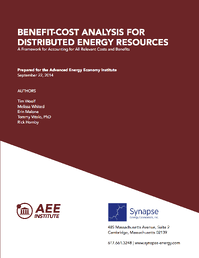 As the U.S. gets closer to a 21st century electricity system, how energy is distributed, managed, and consumed becomes just as important as how energy is generated. Two of the fastest-growing segments in the advanced energy industry today are demand response and energy storage. Each has huge potential for market growth, and we see it in this week’s headlines.
As the U.S. gets closer to a 21st century electricity system, how energy is distributed, managed, and consumed becomes just as important as how energy is generated. Two of the fastest-growing segments in the advanced energy industry today are demand response and energy storage. Each has huge potential for market growth, and we see it in this week’s headlines.
First, according to a new report from Navigant, the global demand response (DR) market is set to increase six-fold in less than a decade, from 31 gigawatts (GW) today to 196 GW by 2023. Both commercial/industrial and residential sectors will drive DR growth, according to the report.
It only makes sense. As more and more legacy power plants retire over the coming decade, implementing systems that meets peak demand by reducing usage rather than maintaining generating capacity only used at those times. DR has proved a vital tool for utilities and grid operators faced with extreme weather patterns – the “heat dome” of 2013 springs to mind, when the New York Independent System Operator called the DR program “crucial” for keeping the lights on.
(DR was one of our featured Advanced Energy Technologies of the Week earlier this month. Learn more about DR here, and be sure to check out the whole series.)
By bringing down demand overall, energy efficiency also alleviates the pressure of demand peaks. Utility Baltimore Gas and Electric Co. (BGE) announced this week that its energy efficiency program, BGR Smart Energy Savers, is saving 1.8 billion kilowatt hours (kWh) per year – enough to power 165,000 homes, according to the utility. The program, which is supported by AEE Member Opower, also includes Smart Energy Rewards, which encourages customers to cut their usage at times of peak demand in the summer. The program allows for participation from renters and homeowners, as well as commercial-scale and institutional customers.
By Opower’s calculations, the program resulted in a 5 percent reduction in peak electric demand, which generated $7 million in savings for BGE customers.
Another way to satisfy demand peaks is with energy storage, which can take electricity generated when demand is low and save it for when it’s needed. This week saw the “unveiling” of the biggest battery in North America, a 32 megawatt-hour behemoth owned by Southern California Edison. The lithium-ion battery system, which has been in development since 2010, is part of a demonstration project at the Monolith substation in the wind-rich Tehachapi Pass. The battery is housed in a 6,300-square-foot building that contains more than 600,000 individual battery cells. Driven by a state mandate to incorporate energy storage into its system, SCE sees this project as a learning opportunity. SCE's Doug Kim said the Tehachapi project “will help us make the right choices.”
Sometimes, peak generation can pose issues as challenging as peak demand. In Hawaii, on sunny days – and there are a lot of those on the islands – the extensive rooftop solar systems installed over recent years generate more electricity than is needed, which can cause problems. (In February, Greentech Media reported on the so-called “Nessie-curve,” which led Hawaiian Electric to halt new PV interconnections late last year.) Hawaiian Electric, the state’s largest utility, contracted with Stem, a California-based startup, to install a 1 MW networked storage pilot project. Stem will be recruiting commercial customers, like hotels and large retailers, to install lithium-ion batteries and control systems.
“What we’re trying to do is to use the storage during the day to deal with the variability of solar, as well as when solar is back-feeding into the system,” Dora Nakafuji, Hawaiian Electric’s director of renewable energy planning, said. “If we can use those to manage those high conditions due to the high penetration of distributed PV, we might be able to get more customers connected, or better plan and target some strategic upgrades that are needed, to accommodate our generation mix.”
And now, from Buffalo, NY, more “Gigafactory” news. AEE member company SolarCity broke ground this week on a mammoth factory to manufacture solar panels in the rust-belt city. It will be three times the size of any other solar panel factory in the U.S., with production beginning by 2017. New York State will invest $750 million in the project.
SolarCity said the factory would bring 3,000 jobs to the area, making it the “single-biggest employment announcement in the Buffalo Niagra region in decades,” according to The Buffalo News. The factory will be built on the site of a former Republic Steel plant. SolarCity is expected to bring more new jobs to the region “than the steel maker ever had in its heyday.”
 In its proceeding on Reforming the Energy Vision, the New York Public Service Commission has undertaken a comprehensive, ambitious, and forward‐thinking initiative to improve the efficiency of the New York electricity system through the promotion of distributed energy resources (DER). This initiative calls for a new, comprehensive benefit‐cost analysis (BCA) framework that will provide the Commission and other stakeholders with the information necessary to determine which resources will be in the public interest and will best meet the Commission’s energy policy goals. This week AEEI Published a report that seeks to do just that.
In its proceeding on Reforming the Energy Vision, the New York Public Service Commission has undertaken a comprehensive, ambitious, and forward‐thinking initiative to improve the efficiency of the New York electricity system through the promotion of distributed energy resources (DER). This initiative calls for a new, comprehensive benefit‐cost analysis (BCA) framework that will provide the Commission and other stakeholders with the information necessary to determine which resources will be in the public interest and will best meet the Commission’s energy policy goals. This week AEEI Published a report that seeks to do just that.
